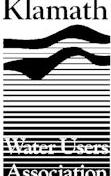
Klamath Water Users Association
Weekly Update
June 20, 2003
|
|
Klamath Water Users Association Weekly Update June 20, 2003
|
| Water
Users Address Upper Klamath Lake Levels Within one week of the U.S. Bureau of Reclamation (Reclamation) announcing wetter water year conditions, Klamath Project irrigators are scrambling to find ways to meet the more restrictive environmental water regulations imposed by the year-type change. Higher regulated lake levels and increased river flow requirements, coupled with recent hot weather and increased irrigation demand, mean that adaptive water management will be required to avoid dropping Upper Klamath Lake (UKL) below minimum regulatory elevations for endangered sucker fish. Local irrigation district managers are employing a variety of measures to prevent a UKL level "bust" and reduce the risk of irrigation curtailment. "We don’t want to curtail deliveries," said Reclamation Klamath Basin Area Office Manager Dave Sabo to irrigation managers earlier today. "We need to brainstorm to find ways to hold the lake levels up." Klamath Project irrigators responded with a variety of measures intended to address this objective:
Reclamation officials will approach The Nature Conservancy and the U.S. Bureau of Land Management to investigate opportunities to supplement UKL levels with water stored on lands above the lake. U.S. Fish and Wildlife refuge managers will also assess whether water management actions taken in the Klamath Marsh refuge might help with downstream UKL water levels. Last Friday, Reclamation changed the 2003 water year designation to "below average" rather than "dry", as forecasted earlier this spring. The change in the 2003 designation – contrary to intuition – actually puts farmers in a more precarious situation because it results in more water being held in Upper Klamath Lake (UKL) for suckers and more water flowing down the Klamath River from Iron Gate Dam for coho salmon. For the remainder of June, the new water year designation triggers UKL levels that are 0.6 feet higher and Klamath River flows that are 300 cubic feet per second (cfs) higher than the requirements for a dry year. A wet April increased the flow of water into Upper Klamath Lake, which triggered the June 13th change in designation. The latest challenge facing local water users is yet another example of the difficulties associated with placing the sole burden for avoiding species’ jeopardy on one federal project. Last year, a similar conflict arose late in the summer, and farmers were asked to reduce irrigation by ten percent. The actions taken then – including groundwater substitution and early fallowing – likely contributed to the availability of water used last fall to provide a "pulse flow" of water intended to aid salmon dying on the Lower Klamath River. Tribes Call for Higher Flows – Again Downstream Klamath River interests – employing a strategy they used successfully late last fall – are pointing to dead fish near the Scott River confluence as evidence that higher releases from Iron Gate Dam are needed in the next month. In an e-mail message to the U.S. Bureau of Reclamation (Reclamation) that was widely circulated among agencies and stakeholders earlier today, Ronnie Pierce, spokesperson/biologist for the Karuk Tribe, called for "a large flow increase for the remainder of June and the first half of July" to ameliorate river conditions to "minimize the escalation of mortalities". In an earlier memo sent to Reclamation, Pierce warned "Unless the Klamath flow schedule for June is changed things are setting up for a repeat of the large (250,000) juvenile fish kill that occurred in June of 2000." Estimates for the number of dead fish range between 40 and 100 found over the past several weeks. Pierce is one member of a downstream technical team that has recommended increasing flows from Iron Gate Dam. The team contends that the increase in flow will benefit salmonids by:
Klamath Project water users are concerned that releasing more warm water from Iron Gate will not provide cooler river temperatures needed by fish. Limbaugh and Rinne Named Deputy Commissioners at Reclamation Bureau of Reclamation Commissioner John W. Keys III today named two
Deputy Commissioners. Mark A. Limbaugh, current Director, External and
Intergovernmental Affairs, and William E. Rinne, current Director,
Operations, assumed their new duties on June 18, 2003. Both executives'
positions will be expanded to include larger responsibilities as part of an
overall reorganization of the bureau's executive leadership. CALENDAR OF EVENTS Monday, July 7, 2003 - Klamath Hydro Project FERC Relicensing Aquatics Meeting. 12:00 p.m. Iron Gate Hatchery. Tuesday, July 8, 2003 – Klamath Hydro Project FERC Relicensing Aquatics
Meeting. 8:30 a.m. Windmill Inn, Ashland, Oregon. |
|
Klamath Water Users
Association |
Content and Logo: Copyright © Klamath
Water Users Association, 2002 All Rights
Reserved
Page design: Copyright ©
klamathbasincrisis.org, 2002, All Rights
Reserved